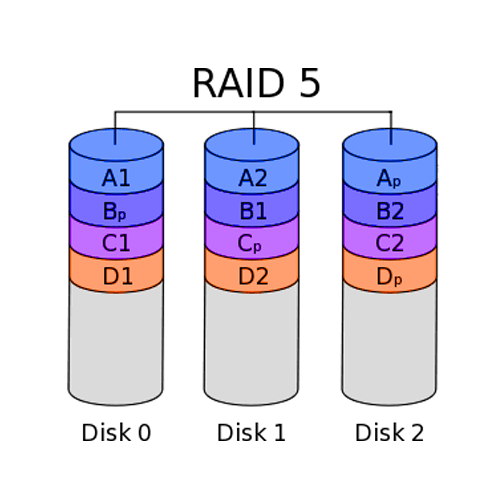What Is RAID?
As it was originally proposed, the acronym RAID stood for Redundant Array of Inexpensive Disks. However, it has since come to be known as Redundant Array of Independent Disks. RAID was originally described in the paper "A Case for Redundant Arrays of Inexpensive Disks (RAID)" written by three University of California Berkeley researchers: David Patterson, Garth Gibson, and Randy Katz. The concept was presented at the 1988 conference of the ACM Special Interest Group on Management of Data (SIGMOD).
In the original Berkeley paper there were five RAID levels (1-5). RAID-6 was added later as an enhancement for RAID-5. In time other levels have been implemented by various companies using the concepts described in the original proposal. These include RAID-0 (striping without redundancy), and multilevel RAID (striping across RAID arrays), and others variants.
The Levels of RAID
| RAID 0 | RAID 1 | RAID 10 (also known as RAID 0/1) |
RAID 5 | |
| Description | Data striping (no data protection) |
Disk mirroring | RAID 0 and RAID 1 combined | Data striping with distributed parity |
| Minimum # of Drives | Two | Two | Four | Three |
| Benefit | Highest performance | Data protection through redundancy | Highest performance with data protection | Best balance of cost/ performance/ data protection |
RAID 5
Combines data striping (for enhanced performance) with distributed parity (for data protection) to provide a recovery path in case of disk drive failure.

The cost of calculating and storing parity, rather than redundant data, is the extra time taken during write operations to regenerate the parity information. This additional time results in a degradation of write performance for RAID-5 arrays over RAID-1 arrays. A RAID-5 write operation is 33% to 60% slower than a RAID-1 write operation. Because of this, RAID-5 arrays are not recommended for applications in which write performance is critically important or is the dominant type of I/O operation.
Due to trade off between performance, fault tolerance, and cost, RAID-5 is probably the most common RAID implementation. This RAID level is a good choice for file and application servers. It is also commonly used for Internet and intranet servers.




